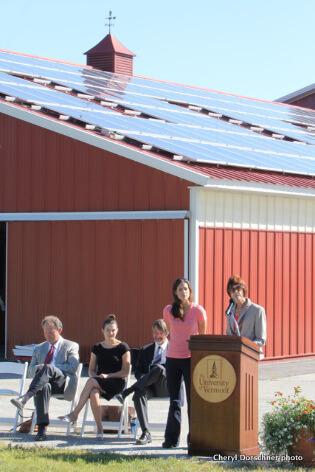The south-facing roof of UVM's Ellen A. Hardacre Equine Center at the Miller Research Farm gleams with 134 new solar panels that all UVM students can proudly say they funded with their contributions to the University's Clean Energy Fund. But one student, Rachel Cadwallader-Staub '10, made it happen when she took an idea she had in class one Monday morning, and by the following Sunday eve, turned that idea into the award-winning grant that paid for the installation.
That makes it sound easy. It wasn't, of course.
Her professor told the story. "In fall of 2009 during my lecture on ways to minimize the environmental impact of horses and incorporate renewable energy sources for equine facilities, I lamented that when the Hardacre Equine Center was built in 1999, solar wasn't an option, said Josie Davis, associate dean of UVM's College of Agriculture and Life Sciences and an equine studies program lecturer. "After class, Rachel suggested that the newly formed UVM Clean Energy Fund might fund a solar array on the equine facility roof. Then she added, 'but the deadline for grants is this Sunday.'"
"Isn't it crazy that we have this enormous south-facing roof on the equine center and there are no solar panels?" Cadwallader-Staub asked with determination. "If you are game, I think I have time to do the leg work."
Davis, who is overseeing the long-term revitalization of UVM Farms, gave Cadwallader-Staub the blueprints, contact information on builders and the electric company and offered advice while away at a conference. They beat the deadline by an hour.
Not only was the proposal funded, it was one of the best the decisionmakers had reviewed, said Gioia Thompson, director of UVM's Office of Sustainability, which oversees the Fund. The Fund, launched in 2008, is fed by a $10 per semester student fee. That adds up to $225,000 annually destined to create new clean energy projects on campus. This is the newest of 21 Clean Energy Fund projects so far that demonstrate that small donations can have a huge impact when a community combines efforts.
The total cost of the solar array was $135,990; the Clean Energy Fund supplied $80,250 and a $55,740 incentive grant from the state's Clean Energy Development Fund made up the difference.
What's Under the Roof
The rooftop panels were completed this summer, and the system went active in September. In the barn, the ticking sound in a grey metal wall-mounted box is like the sound of coins dropping into a bank. The system will produce a daily average of 100 kilowatt hours of electricity – enough for 8 1/2 percent of the University's Miller Research Farms electrical needs (or the equivalent power for six medium sized homes).
For every kilowatt hour of electricity the solar array produces, UVM gains a value of roughly 20 cents: about 14 cents for the average retail price of a kilowatt of electricity it doesn’t need to buy plus a six cent solar premium that Green Mountain Power pays for every kilowatt generated. Bottom line: The credit program should generate about $8,000 per year, allowing UVM to repay its initial investment in 10 years.
If UVM Farms Can Do It, Maybe Others Can Too
“We hope the solar panel project will spark discussion about costs, sustainability and clean energy, as well as demonstrate the nuts and bolts of how and where solar panels can be installed, said Tom Vogelmann, who leads UVM’s College of Agriculture and Life Sciences as its dean. “As a land-grant institution, UVM needs to model the most innovative ways of contributing to the viability of agriculture in our state.”
UVM Farms solar array also makes use of a much underutilized resource on Vermont farms – rooftops, pointed out Clark Hinsdale, president of the Vermont Farm Bureau, who says he sees the value of farmers replicating this concept when it becomes cost effective. “Most agricultural businesses have a lot of roof space,” he said. “Solar is a renewable resource that doesn’t have to use land and can be a nice supplemental income source for farmers.”
“An important aspect of the UVM demonstration project is that farmers can visit, see how the system was installed, understand its economics and the incentives that are available, and determine if the technology is feasible at their own farms," said Chuck Ross, secretary of the Vermont Agency of Agriculture, Food and Markets. UVM students deserve real credit for conceiving and funding this important education and outreach tool.”"It started as a really crazy idea and a great dream," said Rachel Cadwallader-Staub, who now works as manager of Shelburne Farms children's farmyard. "But if you don't try, the answer is 'no.'" Jeff Wakefield contributed to this story.
